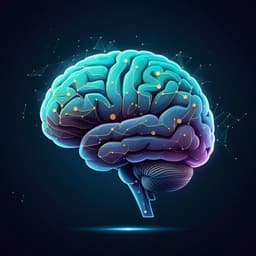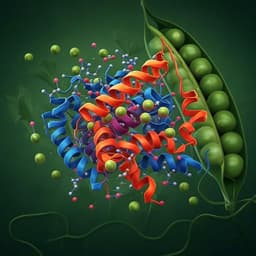
Health and Fitness
Beneficial effects of daytime high-intensity light exposure on daily rhythms, metabolic state and affect
C. Bilu, H. Einat, et al.
This groundbreaking research conducted by Carmel Bilu, Haim Einat, Paul Zimmet, Vicktoria Vishnevskia-Dai, and Noga Kronfeld-Schor reveals that morning exposure to high-intensity light can significantly enhance metabolic health in sand rats. Improve daily rhythms, glucose tolerance, and even reduce anxiety—can the power of light transform our health?
~3 min • Beginner • English
Introduction
The study investigates whether daytime bright light treatment (BLT) in the morning can prevent or ameliorate circadian rhythm-related pathologies, including metabolic dysregulation and affective disturbances, by resynchronizing disrupted circadian rhythms. Background: BLT is an established therapy for mood and certain sleep disorders, presumed to act via melanopsin-expressing intrinsically photosensitive retinal ganglion cells that project to non-visual brain regions including the suprachiasmatic nuclei (SCN). Circadian disruption is closely linked to metabolic syndrome/circadian syndrome and type 2 diabetes mellitus (T2DM). Prior human studies indicate BLT may improve mood and insulin sensitivity in subsets of patients with T2DM and depression, though some findings suggest complex metabolic effects. In diurnal sand rats kept under laboratory conditions, short photoperiods induce arrhythmicity, depressive- and anxiety-like behaviors, and T2DM, while outdoor natural light exposure prevents these outcomes. The authors hypothesized that long-term 1 h morning BLT would prevent development of the circadian syndrome by enhancing rhythm amplitude and entrainment, thereby improving metabolic and affective states.
Literature Review
The paper reviews evidence that: (1) Morning BLT effectively treats seasonal affective disorder, major depressive episodes, and certain circadian sleep disorders; mechanisms likely involve ipRGCs/melanopsin signaling to the SCN and mood-related regions. (2) Circadian disruption is implicated in metabolic syndrome/circadian syndrome, obesity, and T2DM, with extensive human and animal literature linking circadian regulation to metabolism. (3) Clinical studies report BLT can improve mood and insulin sensitivity in some T2DM patients with depression, including case reports of reduced insulin need or increased insulin sensitivity; however, an acute BLT study in healthy and T2DM men showed increases in fasting/postprandial glucose and triglycerides, suggesting direct metabolic effects and the need for further research. (4) Prior sand rat studies show that short photoperiods exacerbate arrhythmicity, anxiety-/depression-like behaviors, glucose intolerance, adipocyte dysfunction, and cardio-metabolic risk factors, while outdoor exposure to natural environmental cycles (notably daylight) preserves diurnality and prevents T2DM and depression-like behavior. These data motivate testing controlled daytime BLT in a diurnal model.
Methodology
Design: 2×2 factorial with photoperiod (short photoperiod, SP: 5:19 LD; neutral photoperiod, NP: 12:12 LD) and treatment (Control vs Bright Light Treatment, BLT). BLT consisted of daily 1 h exposure at ZT0–ZT1 to 3000 lux, full-spectrum LED light (λ 420–780 nm, 5487 K) for 16 weeks before and during testing; ambient room lighting during light phase was 800 lux (λ 420–780 nm, 5834 K). Groups: Control-NP, BLT-NP, Control-SP, BLT-SP; n=31–34 per group (activity monitoring n=12 per group except BLT-SP n=6 due to technical issue). Animals: 131 male diabetes-prone fat sand rats (Psammomys obesus), 10–11 months old, individually housed at 25 °C with ad libitum water and standard rodent food; initially maintained on a low-energy diet to prevent baseline diabetes; baseline weight and glucose tolerance recorded; group assignment balanced by weight and glucose. Housing: Standard cages; LED light sources ~40 cm above cages; no shelters to ensure equal BLT exposure. Timeline: BLT administered for 16 weeks; Week 16: weights, fasting glucose, OGTT at ZT2, and plasma collection for insulin (10 animals per group). Week 17: behavioral testing (Elevated Plus Maze, EPM; modified Forced Swim Test, FST). Week 18: ophthalmic slit-lamp exam for cataracts; euthanasia at four ZTs (ZT2, ZT8, ZT14, ZT20; n=6–12 per timepoint per group) for tissue collection (blood, SCN, PFC, liver, kidney) and heart removal/weighting. Measures and assays: - Locomotor activity: In-cage IR motion detectors; χ² test (CTools 7.0) to classify rhythmicity; diurnal vs nocturnal defined by >50% activity during light vs dark. - Glucose: Tail-tip blood glucose measured (U-Right TD-4269); OGTT with 2 g/kg oral glucose; blood at 0 and 120 min (ZT2). - Plasma insulin: ELISA (Rat Insulin Ultrasensitive, ALPCO) at ZT2 from 10 animals per group. - Behavioral tests: EPM (open/closed arm times/entries) under 200 lux open-arm lighting, testing 1–3 h after lights-on; modified FST over 2 days; primary outcome “time to sink” (two sink events terminate test). - Gene expression: Total RNA extraction (Qiagen RNeasy); RT-PCR/qRT-PCR for Per2 and β-actin; cycling conditions: RT 42 °C 30 min; PCR 35 cycles (95 °C 1 min, 64 °C 1 min, 72 °C 1 min); primers: Per2 f-tcactcaggagtgcatggag, r-tggtgtttcccaacactgac; Actin f-atgcctgggtacatggtggt, r-cacggacctctacgccaa; normalization to β-actin; comparisons across ZTs within group. - Ophthalmology: Topical anesthesia and dilation; slit-lamp exam; cataract defined as lens opacity (ICD-9 366.9); masked assessment. - Cardiac: Heart excision, cleaning, weighing; heart weight/body weight ratio computed. Statistics: Normality assessed; two-way ANOVA (factors: photoperiod, BLT) with LSD post-hoc; non-normal data analyzed with Kruskal–Wallis tests (effect sizes computed as eta squared based on H); activity rhythmicity via χ²; daily rhythms in glucose and Per2 assessed by one-way ANOVA across ZTs with LSD post-hoc; rhythm significant if at least two ZTs differed; peak-to-trough differences (PTD) compared by t-tests. Ethics: NIH guidelines; IACUC Tel Aviv University approval (L15055).
Key Findings
- Activity rhythms: Under NP or SP without BLT, most animals were arrhythmic or nocturnal; with BLT under NP, 11/12 were diurnal (1/12 arrhythmic); under SP with BLT, animals were nocturnal or arrhythmic. Control-SP had significantly more arrhythmic animals than BLT-SP (χ²(1)=6.2, p=0.01) and Control-NP (χ²(1)=9.2, p=0.002). - Glucose tolerance (OGTT at ZT2, week 16): Short photoperiod elevated fasting glucose [H(1,108)=7.9, p=0.005; Cohen’s d=0.53] and 120-min glucose [H(1,108)=7.5, p=0.006; d=0.51]. BLT reduced fasting glucose [H(1,108)=20.0, p<0.001; d=0.94] and 120-min glucose [H(1,108)=21.5, p<0.001; d=0.98]. - Twenty-four-hour glucose rhythm: No significant daily glucose rhythm in non-BLT groups; significant rhythms in both BLT groups (BLT-NP ANOVA F(3,24)=2.65, p=0.07; post-hoc: ZT8≠ZT2 p=0.03, ZT8≠ZT14 p=0.015; BLT-SP F(3,26)=3.94, p=0.019; ZT8≠ZT14 p=0.02; ZT8≠ZT20 p=0.003). - Rhythmicity vs glucose: Rhythmic animals showed significantly lower 120-min OGTT glucose than arrhythmic animals [H(1,40)=26.4, p<0.001; d=2.8]. - Plasma insulin (ZT2): Photoperiod had no effect [H(1,37)=0.78, p=0.38]; BLT significantly reduced insulin [H(1,37)=12.0, p=0.0008; d=1.35]. Rhythmic animals had lower insulin than arrhythmic [H(1,32)=13.7, p=0.0002; d=1.71]. - Cataract: Photoperiod no effect (χ²(1)=0.03, p=0.86); BLT showed a trend to reduce mature cataracts (Control-NP 5/33, BLT-NP 1/29; Control-SP 4/25, BLT-SP 2/30) (χ²(1)=2.91, p=0.09). - Heart weight: SP increased heart weight [F(1,109)=13.7, p<0.001; d=0.5] and borderline increased heart/body weight ratio [F(1,109)=3.7, p=0.058]. BLT reduced heart weight [F(1,109)=48.4, p<0.001; d=1.2] and heart/body weight ratio [F(1,109)=28.6, p<0.001; d=1.1]; no interaction. - Body weight: No overall group main effects on final weight (photoperiod p=0.45; BLT p=0.32). Over time, both photoperiod [F(1,114)=13.28, p<0.001; d=0.6] and BLT [F(1,114)=4.38, p=0.038; d=0.3], with interaction [F(1,114)=4.05, p=0.046]; BLT-NP showed reduced weight gain vs all other groups (post-hoc p<0.01). - Anxiety-like behavior (EPM): SP reduced open/total time ratio [F(1,60)=7.55, p=0.008; d=0.7] and open time [F(1,60)=8.5, p=0.005; d=0.7]. BLT increased open/total ratio [F(1,60)=4.71, p=0.034; d=0.5] and open time [F(1,60)=5.01, p=0.028; d=0.5]; no interaction. - Depression-like behavior (modified FST): SP tended to reduce time to sink [F(1,58)=3.89, p=0.053; d=0.4]. BLT increased time to sink [F(1,58)=19.35, p<0.001; d=0.9]; no interaction. - Molecular rhythms (Per2 mRNA): SCN: Rhythms present in BLT groups (both photoperiods), absent in controls. PTD significantly larger in BLT-NP vs all other groups. PFC: Rhythm only in BLT-NP; PTD largest in BLT-NP vs others. Liver: Rhythm in both NP groups (control and BLT), not in SP groups; PTD largest in BLT-NP vs others. Kidney: No within-group ANOVA significance, but PTD larger in BLT-NP vs BLT-SP (t(27)=2.25, p=0.03), with a trend NP control > SP control. Overall, BLT increased rhythm amplitude, especially under NP conditions.
Discussion
Morning BLT for 1 h daily restored and strengthened circadian rhythmicity in a diurnal rodent model kept under laboratory conditions that typically induce arrhythmicity and metabolic/affective disturbances. BLT induced significant daily glucose rhythms and Per2 expression rhythms in central (SCN, PFC) and peripheral (liver, kidney) tissues, with increased peak-to-trough amplitudes, particularly under a neutral photoperiod. These circadian improvements were associated with better glycemic control (lower fasting and post-OGTT glucose), lower circulating insulin, reduced heart weight and heart/body weight ratio, reduced weight gain under NP, and amelioration of anxiety- and depression-like behaviors. The findings support the hypothesis that BLT acts via the circadian system—potentially through ipRGC pathways to SCN and mood-related nuclei—to resynchronize and amplify rhythms, thereby improving metabolic and affective outcomes. The results also underscore photoperiod dependency: while BLT improved outcomes under both SP and NP, rhythm amplitude and diurnality were most robust under NP; under SP with BLT, rhythmic animals tended to be nocturnal. Collectively, the data indicate that adequate daytime high-intensity, full-spectrum light is a key environmental cue for proper circadian function and overall health, with translational relevance given modern low daylight exposure and light-at-night.
Conclusion
This study demonstrates that daily morning exposure to high-intensity full-spectrum light (3000 lux) restores circadian rhythmicity and improves metabolic and affective health in diurnal sand rats housed under laboratory conditions. BLT increased the amplitude of behavioral, physiological, and molecular rhythms; improved glucose tolerance, lowered fasting glucose and insulin; reduced heart weight; attenuated anxiety- and depression-like behaviors; and tended to reduce cataract incidence, with the strongest molecular rhythm effects under a neutral photoperiod. These findings suggest that insufficient daytime light exposure is a modifiable factor contributing to circadian disruption and associated cardio-metabolic and mental health risks. Future research should: (1) delineate the mechanisms linking BLT to peripheral metabolic regulation and mood circuits, including ipRGC-SCN and extra-SCN pathways; (2) define dose, spectrum, and timing parameters optimizing benefits; (3) assess long-term outcomes and interactions with photoperiod; and (4) translate to controlled human trials targeting circadian syndrome components with daytime light interventions.
Limitations
Related Publications
Explore these studies to deepen your understanding of the subject.







